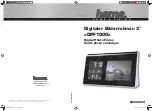
10 lp
30 lp
Spatial Frequency
Sagittal Line
Meridional Line
The MTF chart gives the results at the wide-open aperture.
C
O
N
T
R
A
S
T
IMAGE HEIGHT (mm)
1
0.9
0.8
0.7
0.6
0.5
0.4
0.3
0.2
0.1
0
0
2.5
5
7.5
10
12.5
A Photo Is Only As Good As The Lens It Was Taken With.
The all-important lens
When it comes to photographic
expression, the lens is the most
crucial element. This is true of any
camera, film or digital, and it remains
just as true in any age. Observing the
advances in digital image processing
technology designed to compensate
for lens aberrations, you would think
that digital image compensation was
the answer to everything. However,
no matter how far digital image
processing technology evolves,
it will never rival the descriptive power
of an excellent lens. Some might
argue that an adequate lens is all you
need, as long as you have brilliant
compensation technology. That's not
our view. Sigma is a lens expert, and the
DP1's special lens is the culmination of
years of lens-related R&D.
Just like a high-performance
interchangeable lens
The DP1's integral 16.6mm F4 lens
(equivalent to 28mm on a 35mm
film camera) may be small, but
it's a high-performance wide-angle
single-focus lens designed to the
standards of interchangeable SLR
lenses. Manufactured to exacting
standards, large-diameter (14.5mm)
aspherical glass molds are arranged
in the fourth group. Besides
achieving high resolution and high-
contrast performance, we have
succeeded in storing the whole lens
unit in a compact lens barrel.
Its MTF – the value indicating lens
performance – is on a par with
that of the interchangeable lenses
used in SLR cameras.
A lens that keeps
straight lines straight
In conventional digital cameras,
the techniques used to shorten
the lens barrel cause deterioration
in anti-distortion performance.
This means there is a certain amount
of distortion in the image produced,
which is handled by carrying out
a little compensation in the latter-
stage image-processing. Sigma,
however, has always preferred
to develop lenses with minimal
distortion, or in other words, lenses
that keep straight lines straight.
After all, as an industry leader in
interchangeable lenses, we're not
prepared to compromise when it
comes to lens quality. The DP lens
is a wide-angle lens equivalent to
28mm on a 35mm film camera, but
nevertheless, we have succeeded in
keeping the distortion to within -2.3%
even under the worst conditions
when shooting at close range.
Satisfyingly distortion-free photos,
even with a compact lens: that's
something a DP lens can guarantee.
A lens for full photographic expression
The DP lens uses the Super Multi-
Layer Coating Sigma has developed
over many years of manufacturing
interchangeable lenses for digital
cameras. Despite the compact
lens-barrel, flare and ghosting can be
effectively suppressed even in when
shooting a backlit or semi-backlit
scene, allowing more dramatic
photographic expression.
We've also taken peripheral
brightness into consideration: the
drop in peripheral brightness at the
outermost edge of the screen when
the aperture is released is kept at
-1EV, which is on a par with that of
an interchangeable lens for
a precision digital camera. So, even
when you shoot blue skies whose
brightness continues to the horizon,
your pictures will be bright, clear,
and free of light fall-off at the edges.
A compact digital camera with
integral high-performance lens,
packed with optical technology
smarts, and delivering as much scope
for photographic expression as any
DSLR. That would be the DP1.
The DP1’s integral 16.6mm F4 lens
(equivalent to 28mm on a 35mm
film camera) may be small, but it’s a
high-performance wide-angle single-
focus lens designed to the standards
of interchangeable SLR lenses.
Manufactured to those exacting
standards, large-diameter (14.5mm)
aspherical glass molds are
arranged in the fourth group.
Besides achieving high resolution and
high-contrast performance, we have
succeeded in storing the whole lens
unit in a compact lens barrel.
Its MTF – the value indicating lens
performance – is on a par with that
of the interchangeable lenses
used in SLR cameras.
The construction of
the special-design lens
Sigma Lens 16.6mm F4
MTF Chart
18







































